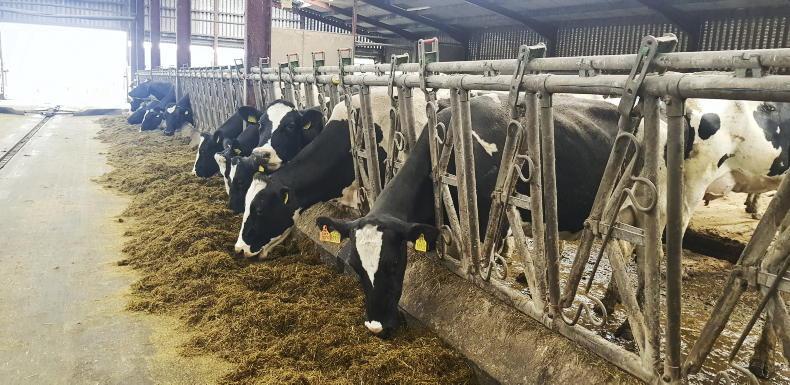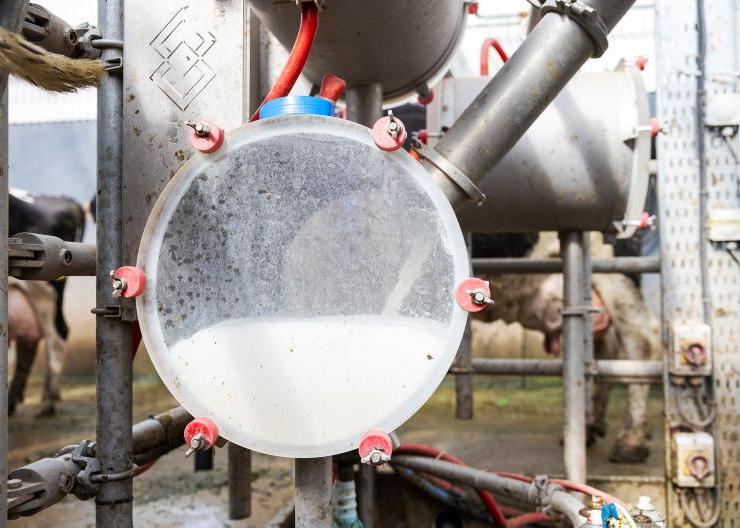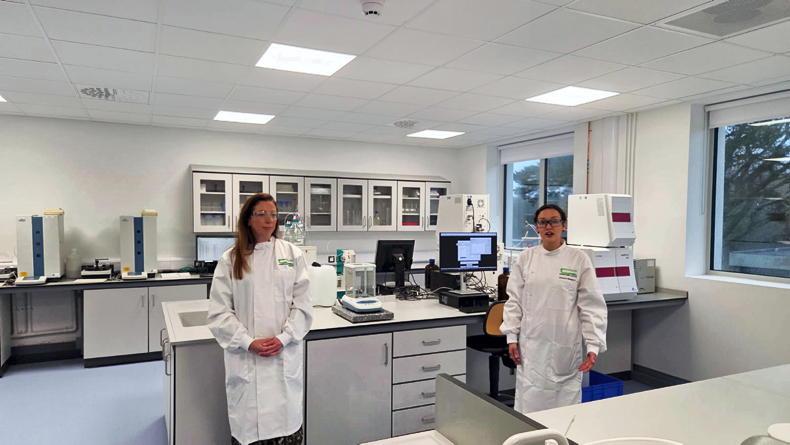With a predominantly autumn-calving herd, a significant proportion of the cows on the Co Antrim farm of James King are approaching peak lactation.
There are currently 160 cows in-milk on the King farm outside Broughshane, producing an average of 31 litres per cow.
With concentrate prices high, and set for another jump in the new year, James has been working closely with his CAFRE Dairylink adviser Kathryn George to ensure cows receive adequate nutrition through the breeding period, and that this feed is used efficiently.
At this stage of the season, milking cows are kept in one group. The latest milk recording shows that 50% of animals are less than 80 days in-milk, and 40% of the herd are producing over 35 litres. At the bottom end, there are only 10 late-lactation cows yielding under 20 litres per head.
“This latest information from milk recording has helped to establish the current feeding regime. It will be monitored as the winter progresses,” advises Kathryn.
She points out that it is energy, not protein, which is the most limiting nutrient in milk production. So if cows are not yielding as much as expected, or if milk solids is below target or cows are losing too much body condition, the energy content of the diet is the first thing to check. “It is crucial for James at this stage that cows are not losing too much body condition in early lactation (no more than 0.5 of a condition score) as this will reduce the ability to get cows back in calf again,” she adds.
The basal cow diet on the King farm includes first and second cut, along with wholecrop wheat.
As shown in Table 1, James has good-quality first and second cut in store, with ME values of 11.5 and 11MJ/kg dry matter (DM) respectively. His wholecrop silage is just under 40% dry matter, with an ME of 10.3MJ/kg. As is typical with this feed, the protein level is quite low at 7.7%.
As a result, when including wholecrop, the diet must be balanced with a higher protein concentrate. But it is also important to remember that even if grass silage has high protein values (above 15%), it is unlikely to meet the protein requirements of high-yielding dairy cows.
During digestion, the majority of the protein from grass silage is broken down by bugs in the rumen, which is too early in the digestive system for it to be fully utilised by the cow. That is why protein products such as soya bean meal are required because a higher proportion of it is able to bypass the rumen and be directly available to the cow via the small intestine.
Intakes
Where wholecrop is included along with grass silage in a total mixed ration (TMR) research has shown that it typically leads to higher DM intakes in dairy cows. The wholecrop is also high in starch (around 30%) and that should help to utilise the protein in the ration more effectively.
At present, James is feeding a basal diet through the wagon to include 9.2kg DM per head of first- and second-cut silage, along with 2.4kg DM of wholecrop and 5kg DM of a 21% protein blend.
This diet will deliver around 190 MJ of energy per head, which is enough to sustain maintenance plus 22 litres for cows. For heifers, it is assumed that the diet will sustain maintenance plus 18 litres.
Beyond that, additional feed is offered in the parlour, with fresh calvers in their first 80 days built up to receive a minimum of 6kg per head, which will support maintenance plus 35 litres. When cows reach 80 days in milk, they then move to feed to yield in the parlour.
Breeding
James began autumn calving towards the end of September, and those cows are now ready to serve again. Breeding started on 30 November, with cows chalked and observed for heats. Sexed semen is being used on the early calvers.
A total of 75 cows were scanned on 1 December, to include pregnancy diagnosis in some stale cows as well as pre-breeding checks in autumn calvers.
Among the autumn calvers, 23 are cycling normally, but 37 require some form of intervention, whether it is a washout, or treatment to help encourage the animal into heat.
Calves
In recent years James has operated a flying herd, but with sexed semen used across a proportion of the cows last year, he has retained 34 heifer calves. Of these, 20 have now been weaned and they are currently on a diet of 2.5kg of concentrate per head, along with free access to straw.
Read more
Dairylink: planning to get better, not bigger
Ready for winter feeding in Co Antrim
With a predominantly autumn-calving herd, a significant proportion of the cows on the Co Antrim farm of James King are approaching peak lactation.
There are currently 160 cows in-milk on the King farm outside Broughshane, producing an average of 31 litres per cow.
With concentrate prices high, and set for another jump in the new year, James has been working closely with his CAFRE Dairylink adviser Kathryn George to ensure cows receive adequate nutrition through the breeding period, and that this feed is used efficiently.
At this stage of the season, milking cows are kept in one group. The latest milk recording shows that 50% of animals are less than 80 days in-milk, and 40% of the herd are producing over 35 litres. At the bottom end, there are only 10 late-lactation cows yielding under 20 litres per head.
“This latest information from milk recording has helped to establish the current feeding regime. It will be monitored as the winter progresses,” advises Kathryn.
She points out that it is energy, not protein, which is the most limiting nutrient in milk production. So if cows are not yielding as much as expected, or if milk solids is below target or cows are losing too much body condition, the energy content of the diet is the first thing to check. “It is crucial for James at this stage that cows are not losing too much body condition in early lactation (no more than 0.5 of a condition score) as this will reduce the ability to get cows back in calf again,” she adds.
The basal cow diet on the King farm includes first and second cut, along with wholecrop wheat.
As shown in Table 1, James has good-quality first and second cut in store, with ME values of 11.5 and 11MJ/kg dry matter (DM) respectively. His wholecrop silage is just under 40% dry matter, with an ME of 10.3MJ/kg. As is typical with this feed, the protein level is quite low at 7.7%.
As a result, when including wholecrop, the diet must be balanced with a higher protein concentrate. But it is also important to remember that even if grass silage has high protein values (above 15%), it is unlikely to meet the protein requirements of high-yielding dairy cows.
During digestion, the majority of the protein from grass silage is broken down by bugs in the rumen, which is too early in the digestive system for it to be fully utilised by the cow. That is why protein products such as soya bean meal are required because a higher proportion of it is able to bypass the rumen and be directly available to the cow via the small intestine.
Intakes
Where wholecrop is included along with grass silage in a total mixed ration (TMR) research has shown that it typically leads to higher DM intakes in dairy cows. The wholecrop is also high in starch (around 30%) and that should help to utilise the protein in the ration more effectively.
At present, James is feeding a basal diet through the wagon to include 9.2kg DM per head of first- and second-cut silage, along with 2.4kg DM of wholecrop and 5kg DM of a 21% protein blend.
This diet will deliver around 190 MJ of energy per head, which is enough to sustain maintenance plus 22 litres for cows. For heifers, it is assumed that the diet will sustain maintenance plus 18 litres.
Beyond that, additional feed is offered in the parlour, with fresh calvers in their first 80 days built up to receive a minimum of 6kg per head, which will support maintenance plus 35 litres. When cows reach 80 days in milk, they then move to feed to yield in the parlour.
Breeding
James began autumn calving towards the end of September, and those cows are now ready to serve again. Breeding started on 30 November, with cows chalked and observed for heats. Sexed semen is being used on the early calvers.
A total of 75 cows were scanned on 1 December, to include pregnancy diagnosis in some stale cows as well as pre-breeding checks in autumn calvers.
Among the autumn calvers, 23 are cycling normally, but 37 require some form of intervention, whether it is a washout, or treatment to help encourage the animal into heat.
Calves
In recent years James has operated a flying herd, but with sexed semen used across a proportion of the cows last year, he has retained 34 heifer calves. Of these, 20 have now been weaned and they are currently on a diet of 2.5kg of concentrate per head, along with free access to straw.
Read more
Dairylink: planning to get better, not bigger
Ready for winter feeding in Co Antrim









SHARING OPTIONS